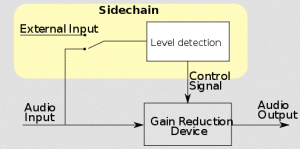What is Sidechaining?
Do you ever get the problem where your mix sounds great on one part of your track, but overcrowded or muddy on another part once more textures come in? If so, you may want to try using sidechaining.

Sidechaining is a production technique used in a wide variety of music genres where an effect is activated by an audio track. In other words, it’s using an alternative audio source to trigger a processor. The alternative source is set to a threshold, which when exceeded activates the effect.
One of the most common examples of this is when radio DJs are talking over some background music. When the DJ speaks, a limiter is activated upon the background music by the audio signal of the DJ talking. This causes the music to drop way down so that it doesn’t interrupt the talking. When he’s finished talking, the silence on his track deactivates the limiter on the background music and it once again becomes louder in the mix.
Another common sidechaining is used is in electronic dance music (EDM) where there’s heavy kick and bass. Often, producers will put sidechain compression on the bass of an EDM track and have it triggered by the kick. This reduces any muddiness that might happen from having too much low frequency sound when the kick and bass play simultaneously.
Most often sidechaining is used with a compressor in the context of a scenario like these two examples where the gain of one track needs to be lowered while another is playing. A popular term for this is “ducking.”
While ducking is most common, producers have come up with other creative ways to use sidechaining to achieve a certain sound in the mix. However you use it, sidechaining can be a powerful tool in your mixing and mastering arsenal.




